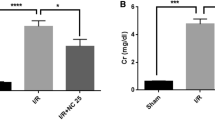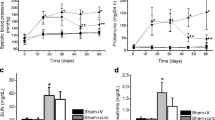Abstract
Objectives
Renal ischemia followed by reperfusion leads to acute renal failure in both native kidneys and renal allograft. We investigated the effect of curcumin on ischemia-reperfusion (I/R) injury and the antioxidant effects of curcumin in rats.
Methods
Thirty rats were randomly divided into five experimental groups (control, sham, curcumin, I/R and I/R + curcumin, n = 6 each). Curcumin was administered (200 mg kg−1) orally to curcumin and I/R + curcumin groups for 7 days. Then, the rats were subjected to bilateral renal ischemia for 45 min and followed by reperfusion for 24 h. All rats were killed and kidney function tests, serum and tissue nitric oxide (NO), protein carbonyl (PC), malondialdehyde (MDA), superoxide dismutase (SOD) and glutathione peroxidase (GSH-Px) levels were determined. Histopathological examinations were also performed.
Results
Curcumin significantly improved the urea and cystatin C levels in I/R + curcumin group compared to I/R group (p < 0.05). Reduction of serum GSH-Px was significantly improved by curcumin (p < 0.001), but SOD enzyme activity did not alter (p > 0.05). Treatment with curcumin also resulted in significant reduction in serum and tissue MDA, NO and PC and for tissue that were increased by renal I/R injury (p < 0.001 for serum and p < 0.05 for tissue, respectively). In histological examination, the rats treated with curcumin had nearly normal morphology of the kidney.
Conclusions
Based on our results, it can be concluded that curcumin protects the kidneys against I/R injury via its antioxidant effects.

Similar content being viewed by others
References
Abernethy VE, Lieberthal W (2002) Acute renal failure in the critically ill patient. Crit Care Clin 18:203–222
Tanabe K, Oshima T, Tokumoto T, Ishikawa N, Kanematsu A, Shinmura H et al (1998) Long-term renal function in nonheart- beating donor kidney transplantation: a single-center experience. Transplantation 66:1708–1713
Perico N, Cattaneo D, Sayegh MH, Remuzzi G (2004) Delayed graft function in kidney transplantation. Lancet 364:1814–1827
Haugen E, Nath KA (1999) The involvement of oxidative stress in the progression of renal injury. Blood Purif 17:58–65
Edelstein CL, Ling H, Schrier RW (1997) The nature of cell injury. Kidney Int 51:1341–1351
Castaneda MP, Swiatecka-Urban A, Mitsnefes MM, Feuerstein D, Kaskel FJ, Tellis V, Devarajan P (2003) Activation of mitochondrial apoptotic pathways in human, renal allografts after ischemia-reperfusion injury. Transplantation 76:50–54
Jagetia GC, Aggarwal BB (2007) “Spicing up” of the immune system by curcumin. J Clin Immunol 27:19–35
Lowry OH, Rosenbrough NJ, Farr AL, Randall RJ (1951) Protein measurement with the Folin phenol reagent. J Biol Chem 193:265–275
Aebi H. (1974) Catalase In: Bergmeyer U (ed) Methods of enzymatic analysis. Academic Press, New York
Sun Y, Oberley LW, Ying L (1988) A simple method for clinical assay of superoxide dismutase. Clin Chem 34:497–500
Paglia DE,Valentine WN (1967) Studies on the quantitative and qualitative characterisation of erythrocyte glutathione peroxidase. J Lab Clin Med 70:158–169
Esterbauer H, Cheeseman KH (1990) Determination of aldehydic lipid peroxidation products: malonaldehyde and 4-hydroxynonenal. In: Packer L, Glazer AN (eds) Oxygen radicals in biological systems, methods in enzymology. Academic Pres, California, pp 407–421
Cortas NK, Wakid NW (1990) Determination of inorganic nitrate in serum and urine by a kinetic cadmium-reduction method. Clin Chem 36:1440–1443
Levine RL, Garland D, Oliver CN, Amici A, Climent I, Lenz AG, Ahn BW, Shaltiel S, Stantman ER (1990) Determination of carbonyl content in oxidatively modified proteins. In: Packer L, Glazer AN (eds) Methods in enzimology V 186, oxygen radicals in biological systems. Academic Press, New York, pp 464–478
Erel O (2004) A novel automated method to measure total antioxidant response against potent free radical reactions. Clin Biochem 37:112–219
Erel O (2005) A new automated colorimetric method for measuring total oxidant status, Clin Biochem 38:1103–1111
Williams PH, Lopez DB, Chan C, Ezrin A, Hottendorf R (1997) Characterization of renal ischemia-reperfusion injury in rats. J Pharmacol Toxicol Methods 37:1–7
Uysal F, Girgin FK, Tuzun S, Aldemir S, Sozmen EY (1998) Effect of vitamin E on antioxidant enzymes and nitric oxide in ischemia-reperfused kidney injury. Biochem Mol Biol Int 44:1255–1263
Sener G, Sehirli O, Velioğlu-Oğünç A, Cetinel S, Gedik N, Caner M, Sakarcan A, Yeğen BC. (2006) Montelukast protects against renal ischemia/reperfusion injury in rats. Pharmacol Res 54:65–71
Singh D, Chander V, Chopra K (2005) Cyclosporine protects against ischemia/reperfusion injury in rat kidneys. Toxicology 207:339–347
Weight SC, Bell PRF, Nicholson ML (1996) Renal ischemia-reperfusion injury. Br J Surg 83:162–170
Shoskes DA (1998) Effect of bioflavonoids quercetin and curcumin on ischemic renal injury: a new class of renoprotective agents. Transplantation 66:147–152
Paller MS, Hoidal JR, Ferris TF (1984) Oxygen free radicals in ischemic acute renal failure in the rat. J Clin Invest 74:1156–1164
Kunchandy E, Rao A (1990) Oxygen radical scavenging activity of curcumin. Int J Pharm 58: 237–240
Ruby AJ, Kuttan G, Babu KD, Rajasekharan KN, Kuttan R (1995) Anti-tumour and antioxidant activity of natural curcuminoids. Cancer Lett 94:79–83
Reddy AC, Lokesh BR (1994) Studies on the inhibitory effects of curcumin and eugenol on the formation of reactive oxygen species and the oxidation of ferrous iron. Mol Cell Biochem 137:1–8
Eschwege P, Paradis V, Conti M, Holstege A, Richet F, Deteve J, Menager P, Legrand A, Jardin A, Bedossa P, Benoit G (1999) In situ detection of lipid peroxidation by-products as markers of renal ischemia injuries in rat kidneys. J Urol 162:553–557
Irmak MK, Koltuksuz U, Kutlu NO, Yagmurca M, Ozyurt H, Karaman A, Akyol O (2001) The effect of caffeic acid phenethyl ester on ischemia-reperfusion injury in comparison with alpha-tocopherol in rat kidneys. Urol Res 29:190–193
Sreejayan N, Rao MN (1994) Curcuminoids as potent inhibitors of lipid peroxidation. J Pharm Pharmacol 46:1013–1016
Rhoden EL, Rhoden CR, Lucas ML, Pereira-Lima L, Zettler C, Bello-Klein A (2002) The role of nitric oxide pathway in the renal ischemia-reperfusion injury in rats. Transpl Immunol 10:277–284
Conflict of interest statement
There is no conflict of interest.
Author information
Authors and Affiliations
Corresponding author
Rights and permissions
About this article
Cite this article
Bayrak, O., Uz, E., Bayrak, R. et al. Curcumin protects against ischemia/reperfusion injury in rat kidneys. World J Urol 26, 285–291 (2008). https://doi.org/10.1007/s00345-008-0253-4
Received:
Accepted:
Published:
Issue Date:
DOI: https://doi.org/10.1007/s00345-008-0253-4




